聊聊Disruptor 和 Aeron 这两个开源库
聊聊Disruptor 和 Aeron 这两个开源库
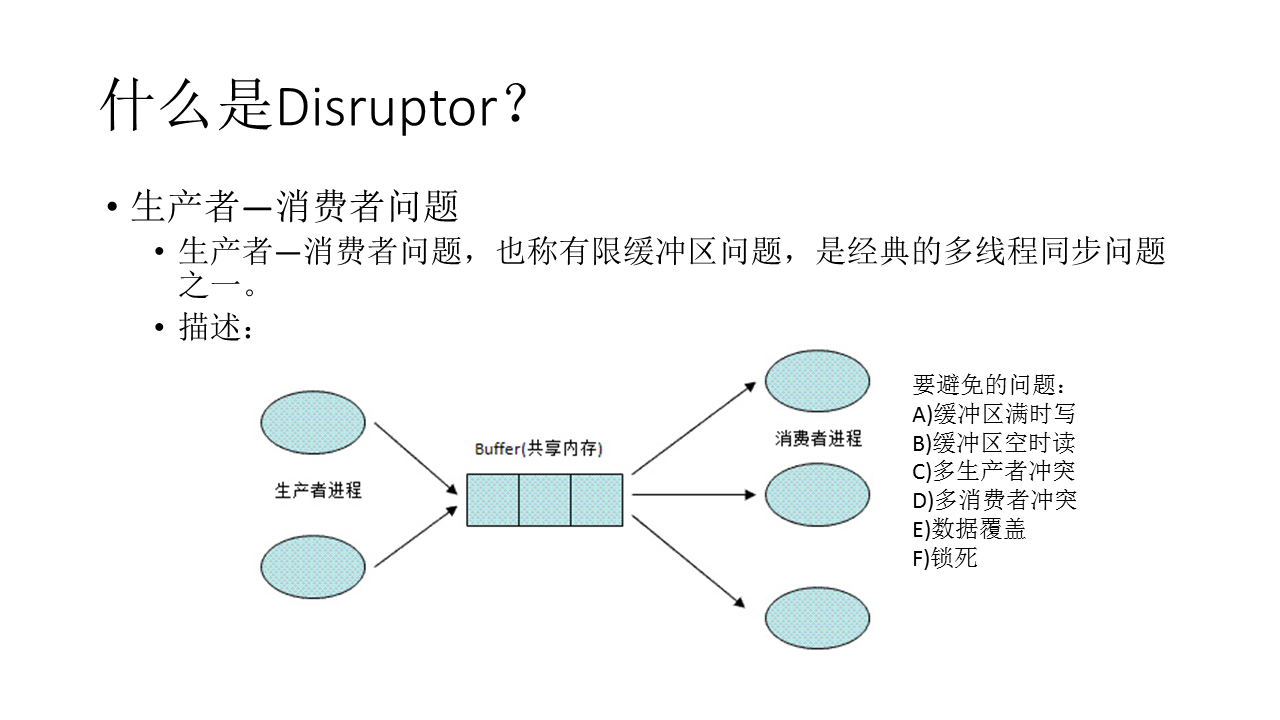
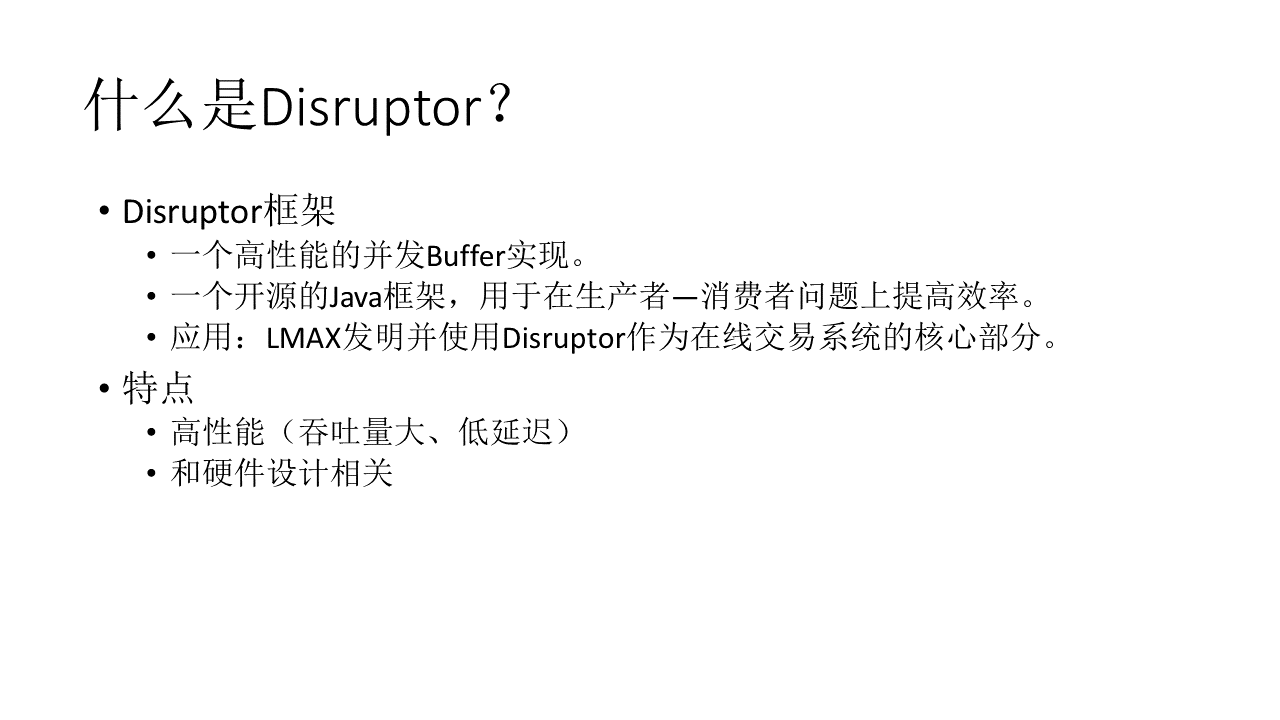

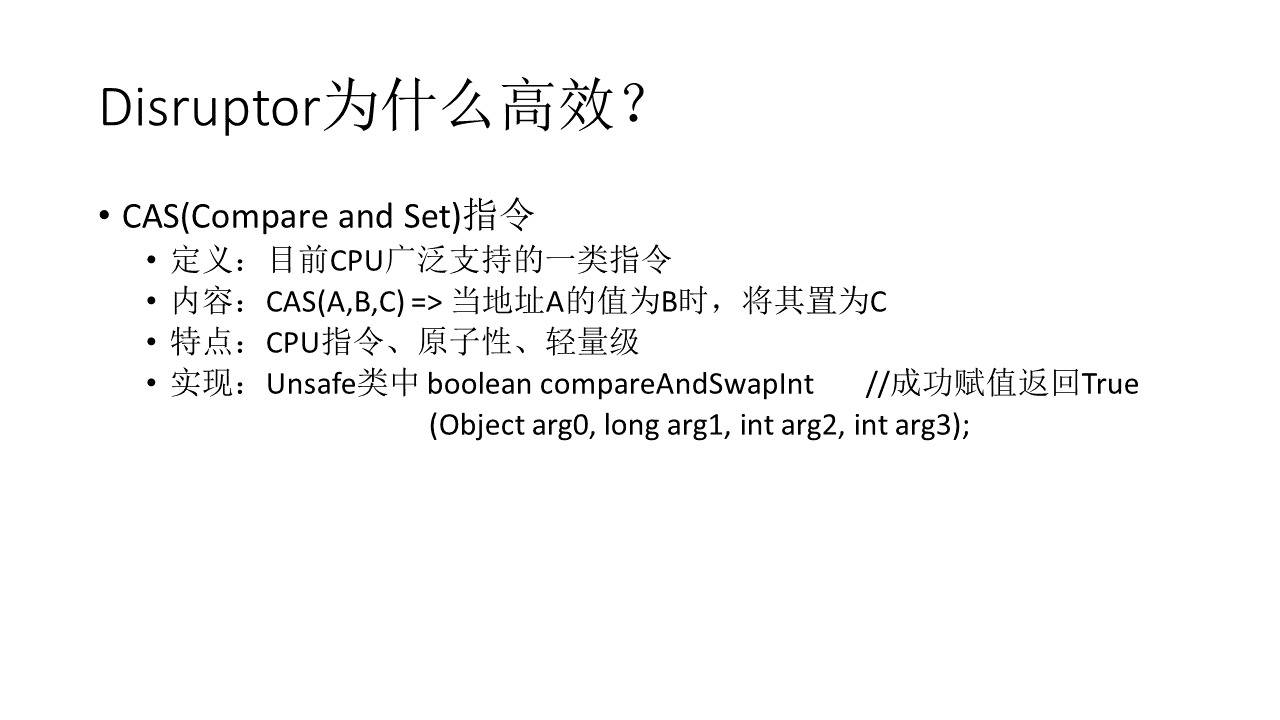
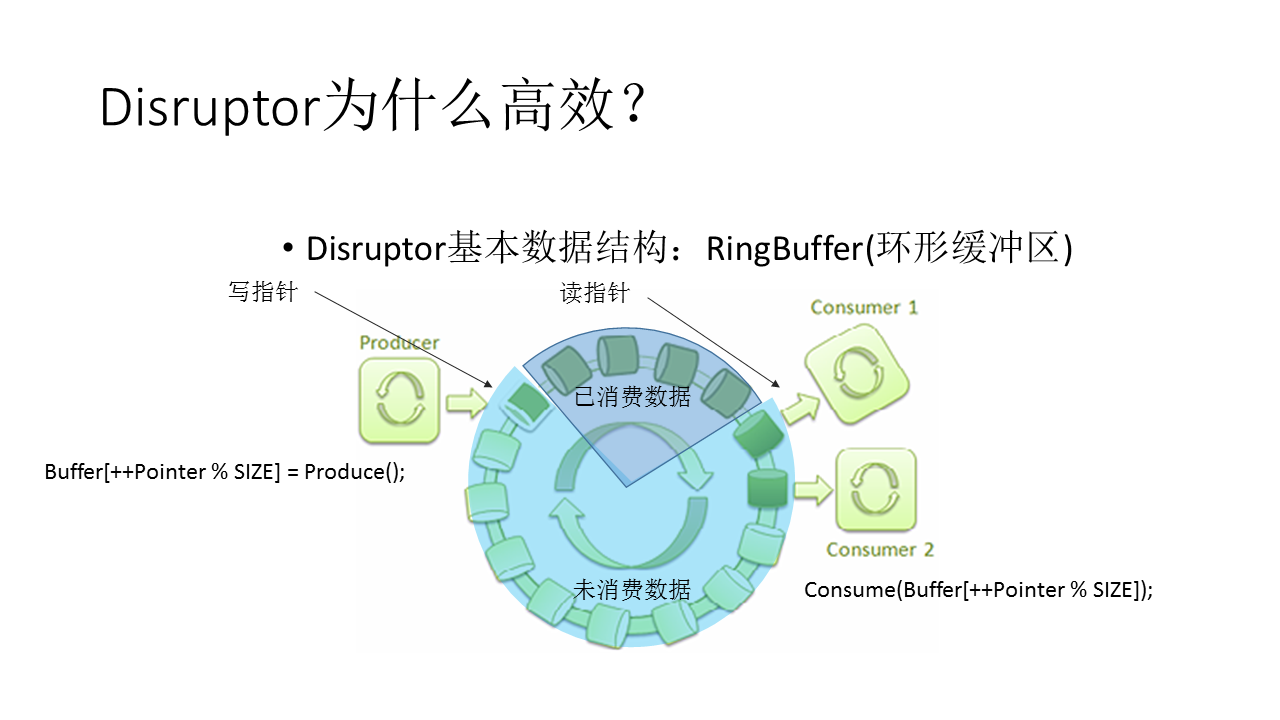
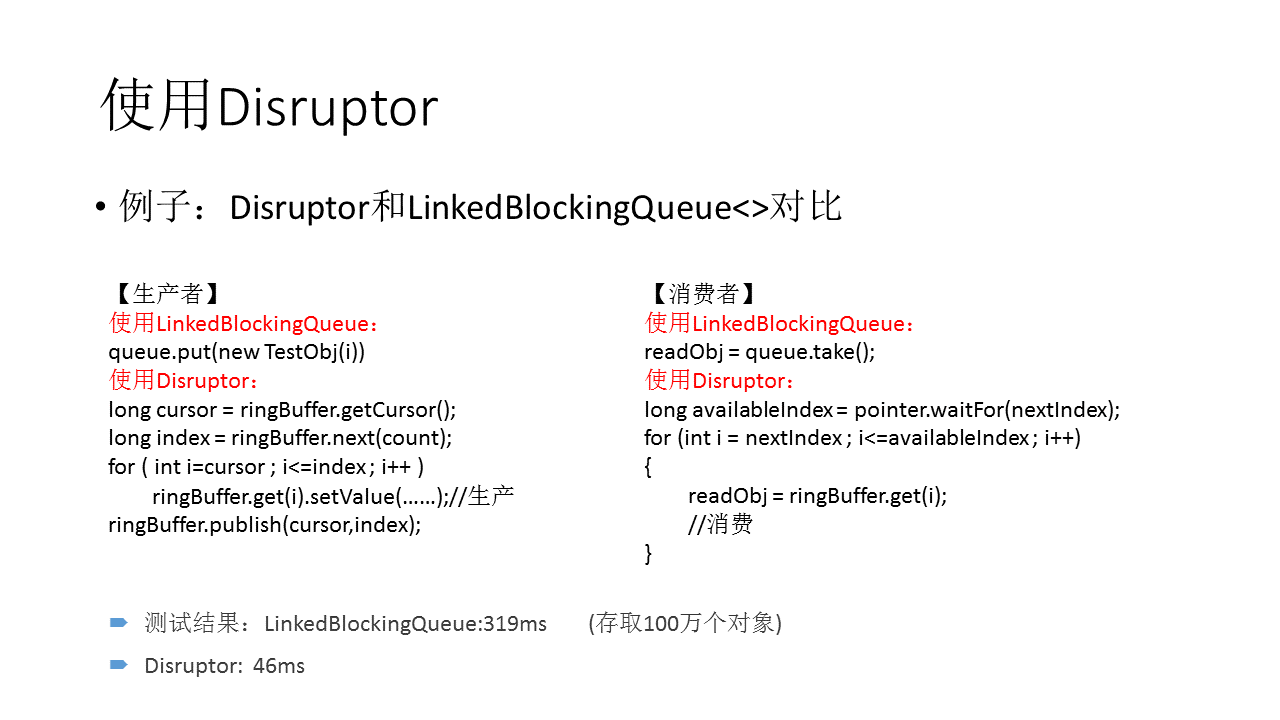
Disruptor
The best way to understand what the Disruptor is, is to compare it to something well understood and quite similar in purpose. In the case of the Disruptor this would be Java's BlockingQueue. Like a queue the purpose of the Disruptor is to move data (e.g. messages or events) between threads within the same process. However there are some key features that the Disruptor provides that distinguish it from a queue. They are:
•Multicast events to consumers, with consumer dependency graph.
•Pre-allocate memory for events.
•Optionally lock-free.
Core Concepts
Before we can understand how the Disruptor works, it is worthwhile defining a number of terms that will be used throughout the documentation and the code. For those with a DDD bent, think of this as the ubiquitous language of the Disruptor domain.
•Ring Buffer: The Ring Buffer is often considered the main aspect of the Disruptor, however from 3.0 onwards the Ring Buffer is only responsible for the storing and updating of the data (Events) that move through the Disruptor. And for some advanced use cases can be completely replaced by the user.
•Sequence: The Disruptor uses Sequences as a means to identify where a particular component is up to. Each consumer (EventProcessor) maintains a Sequence as does the Disruptor itself. The majority of the concurrent code relies on the the movement of these Sequence values, hence the Sequence supports many of the current features of an AtomicLong. In fact the only real difference between the 2 is that the Sequence contains additional functionality to prevent false sharing between Sequences and other values.
•Sequencer: The Sequencer is the real core of the Disruptor. The 2 implementations (single producer, multi producer) of this interface implement all of the concurrent algorithms use for fast, correct passing of data between producers and consumers.
•Sequence Barrier: The Sequence Barrier is produced by the Sequencer and contains references to the main published Sequence from the Sequencer and the Sequences of any dependent consumer. It contains the logic to determine if there are any events available for the consumer to process.
•Wait Strategy: The Wait Strategy determines how a consumer will wait for events to be placed into the Disruptor by a producer. More details are available in the section about being optionally lock-free.
•Event: The unit of data passed from producer to consumer. There is no specific code representation of the Event as it defined entirely by the user.
•EventProcessor: The main event loop for handling events from the Disruptor and has ownership of consumer's Sequence. There is a single representation called BatchEventProcessor that contains an efficient implementation of the event loop and will call back onto a used supplied implementation of the EventHandler interface.
•EventHandler: An interface that is implemented by the user and represents a consumer for the Disruptor.
•Producer: This is the user code that calls the Disruptor to enqueue Events. This concept also has no representation in the code.
Aeron
Aeron is an OSI layer 4 Transport for message-oriented streams. It works over UDP or IPC, and supports both unicast and multicast. The main goal is to provide an efficient and reliable connection with a low and predictable latency. Aeron has Java, C++ and .NET clients.
When to use?
A high and predictable performance is a main advantage of Aeron, it’s most useful in application which requires low-latency, high throughput (e.g. sending large files) or both (akka remoting uses Aeron).
If it can work over UDP, why not to use UDP?
The main goal of Aeron is high performance. That is why it makes sense why it can work over UDP but doesn’t support TCP. But someone can ask what features Aeron provides on top of UDP?
Aeron is OSI Layer 4 (Transport) Services. It supports next features:
1. Connection Oriented Communication
2. Reliability
3. Flow Control
4. Congestion Avoidance/Control
5. Multiplexing
Architecture
Aeron uses unidirectional connections. If you need to send requests and receive responses, you should use two connections.Publisher and Media Driver (see later) are used to send a message, Subscriber and Media Driver — to receive. Client talks to Media Driver via shared memory.
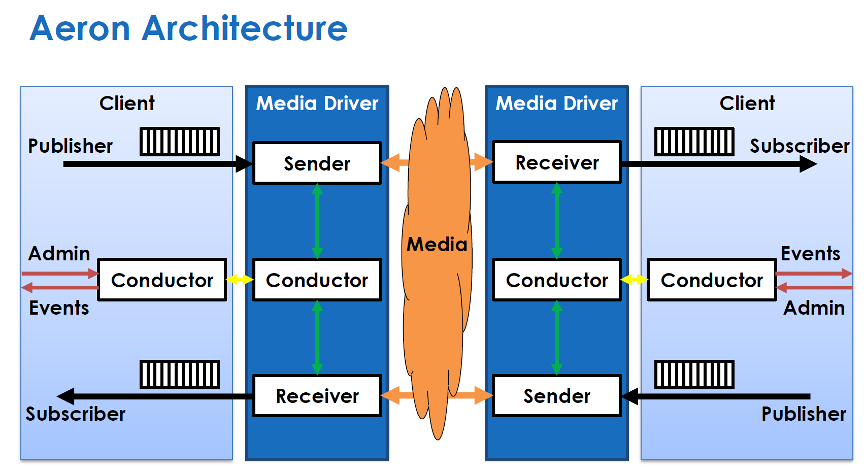
为什么将这两个库在一起聊呢,通常Disruptor框架的核心数据结构circular buffer是Java实现的,主要原因是Java对并发的支持比较友好,而且比较早的支持了内存模型,但是 C++ 11以后,C++ 同样在并发方面有了长足的进步, Aeron就是在这个背景下产生的,虽然核心代码依旧是Java,但是在对C++客户端支持的设计中也实现了比较多的,有价值的数据结构,比如OneToOneRingBuffer, ManyToOneRingBuffer。
下面就以OneToOneRingBuffer为例进行说明,
/*
* Copyright 2014-2020 Real Logic Limited.
*
* Licensed under the Apache License, Version 2.0 (the "License");
* you may not use this file except in compliance with the License.
* You may obtain a copy of the License at
*
* https://www.apache.org/licenses/LICENSE-2.0
*
* Unless required by applicable law or agreed to in writing, software
* distributed under the License is distributed on an "AS IS" BASIS,
* WITHOUT WARRANTIES OR CONDITIONS OF ANY KIND, either express or implied.
* See the License for the specific language governing permissions and
* limitations under the License.
*/ #ifndef AERON_RING_BUFFER_ONE_TO_ONE_H
#define AERON_RING_BUFFER_ONE_TO_ONE_H #include <climits>
#include <functional>
#include <algorithm>
#include "util/Index.h"
#include "util/LangUtil.h"
#include "AtomicBuffer.h"
#include "Atomic64.h"
#include "RingBufferDescriptor.h"
#include "RecordDescriptor.h" namespace aeron { namespace concurrent { namespace ringbuffer { class OneToOneRingBuffer
{
public:
explicit OneToOneRingBuffer(concurrent::AtomicBuffer &buffer) :
m_buffer(buffer)
{
m_capacity = buffer.capacity() - RingBufferDescriptor::TRAILER_LENGTH; RingBufferDescriptor::checkCapacity(m_capacity); m_maxMsgLength = m_capacity / ; m_tailPositionIndex = m_capacity + RingBufferDescriptor::TAIL_POSITION_OFFSET;
m_headCachePositionIndex = m_capacity + RingBufferDescriptor::HEAD_CACHE_POSITION_OFFSET;
m_headPositionIndex = m_capacity + RingBufferDescriptor::HEAD_POSITION_OFFSET;
m_correlationIdCounterIndex = m_capacity + RingBufferDescriptor::CORRELATION_COUNTER_OFFSET;
m_consumerHeartbeatIndex = m_capacity + RingBufferDescriptor::CONSUMER_HEARTBEAT_OFFSET;
} OneToOneRingBuffer(const OneToOneRingBuffer &) = delete;
OneToOneRingBuffer &operator=(const OneToOneRingBuffer &) = delete; inline util::index_t capacity() const
{
return m_capacity;
} bool write(std::int32_t msgTypeId, concurrent::AtomicBuffer &srcBuffer, util::index_t srcIndex, util::index_t length)
{
RecordDescriptor::checkMsgTypeId(msgTypeId);
checkMsgLength(length); const util::index_t recordLength = length + RecordDescriptor::HEADER_LENGTH;
const util::index_t requiredCapacity = util::BitUtil::align(recordLength, RecordDescriptor::ALIGNMENT);
const util::index_t mask = m_capacity - ; std::int64_t head = m_buffer.getInt64(m_headCachePositionIndex);
std::int64_t tail = m_buffer.getInt64(m_tailPositionIndex);
const util::index_t availableCapacity = m_capacity - (util::index_t)(tail - head); if (requiredCapacity > availableCapacity)
{
head = m_buffer.getInt64Volatile(m_headPositionIndex); if (requiredCapacity > (m_capacity - (util::index_t)(tail - head)))
{
return false;
} m_buffer.putInt64(m_headCachePositionIndex, head);
} util::index_t padding = ;
auto recordIndex = static_cast<util::index_t>(tail & mask);
const util::index_t toBufferEndLength = m_capacity - recordIndex; if (requiredCapacity > toBufferEndLength)
{
auto headIndex = static_cast<std::int32_t>(head & mask); if (requiredCapacity > headIndex)
{
head = m_buffer.getInt64Volatile(m_headPositionIndex);
headIndex = static_cast<std::int32_t>(head & mask); if (requiredCapacity > headIndex)
{
return false;
} m_buffer.putInt64Ordered(m_headCachePositionIndex, head);
} padding = toBufferEndLength;
} if ( != padding)
{
m_buffer.putInt64Ordered(
recordIndex, RecordDescriptor::makeHeader(padding, RecordDescriptor::PADDING_MSG_TYPE_ID));
recordIndex = ;
} m_buffer.putBytes(RecordDescriptor::encodedMsgOffset(recordIndex), srcBuffer, srcIndex, length);
m_buffer.putInt64Ordered(recordIndex, RecordDescriptor::makeHeader(recordLength, msgTypeId));
m_buffer.putInt64Ordered(m_tailPositionIndex, tail + requiredCapacity + padding); return true;
} int read(const handler_t &handler, int messageCountLimit)
{
const std::int64_t head = m_buffer.getInt64(m_headPositionIndex);
const auto headIndex = static_cast<std::int32_t>(head & (m_capacity - ));
const std::int32_t contiguousBlockLength = m_capacity - headIndex;
int messagesRead = ;
int bytesRead = ; auto cleanup = util::InvokeOnScopeExit {
[&]()
{
if (bytesRead != )
{
m_buffer.setMemory(headIndex, bytesRead, );
m_buffer.putInt64Ordered(m_headPositionIndex, head + bytesRead);
}
}}; while ((bytesRead < contiguousBlockLength) && (messagesRead < messageCountLimit))
{
const std::int32_t recordIndex = headIndex + bytesRead;
const std::int64_t header = m_buffer.getInt64Volatile(recordIndex);
const std::int32_t recordLength = RecordDescriptor::recordLength(header); if (recordLength <= )
{
break;
} bytesRead += util::BitUtil::align(recordLength, RecordDescriptor::ALIGNMENT); const std::int32_t msgTypeId = RecordDescriptor::messageTypeId(header);
if (RecordDescriptor::PADDING_MSG_TYPE_ID == msgTypeId)
{
continue;
} ++messagesRead;
handler(
msgTypeId, m_buffer, RecordDescriptor::encodedMsgOffset(recordIndex),
recordLength - RecordDescriptor::HEADER_LENGTH);
} return messagesRead;
} inline int read(const handler_t &handler)
{
return read(handler, INT_MAX);
} inline util::index_t maxMsgLength() const
{
return m_maxMsgLength;
} inline std::int64_t nextCorrelationId()
{
return m_buffer.getAndAddInt64(m_correlationIdCounterIndex, );
} inline void consumerHeartbeatTime(std::int64_t time)
{
m_buffer.putInt64Ordered(m_consumerHeartbeatIndex, time);
} inline std::int64_t consumerHeartbeatTime() const
{
return m_buffer.getInt64Volatile(m_consumerHeartbeatIndex);
} inline std::int64_t producerPosition() const
{
return m_buffer.getInt64Volatile(m_tailPositionIndex);
} inline std::int64_t consumerPosition() const
{
return m_buffer.getInt64Volatile(m_headPositionIndex);
} inline std::int32_t size() const
{
std::int64_t headBefore;
std::int64_t tail;
std::int64_t headAfter = m_buffer.getInt64Volatile(m_headPositionIndex); do
{
headBefore = headAfter;
tail = m_buffer.getInt64Volatile(m_tailPositionIndex);
headAfter = m_buffer.getInt64Volatile(m_headPositionIndex);
}
while (headAfter != headBefore); return static_cast<std::int32_t>(tail - headAfter);
} bool unblock()
{
return false;
} private:
concurrent::AtomicBuffer &m_buffer;
util::index_t m_capacity;
util::index_t m_maxMsgLength;
util::index_t m_headPositionIndex;
util::index_t m_headCachePositionIndex;
util::index_t m_tailPositionIndex;
util::index_t m_correlationIdCounterIndex;
util::index_t m_consumerHeartbeatIndex; inline void checkMsgLength(util::index_t length) const
{
if (length > m_maxMsgLength)
{
throw util::IllegalArgumentException(
"encoded message exceeds maxMsgLength of " + std::to_string(m_maxMsgLength) +
" length=" + std::to_string(length),
SOURCEINFO);
}
}
}; }}} #endif
使用示例
AtomicBuffer ab(&buff[], buff.size());
OneToOneRingBuffer ringBuffer(ab); util::index_t tail = ;
util::index_t head = ; ab.putInt64(HEAD_COUNTER_INDEX, head);
ab.putInt64(TAIL_COUNTER_INDEX, tail); std::cout <<"circular buffer capacity is : "<<ringBuffer.capacity() << std::endl;
util::index_t length = ;
util::index_t recordLength = length + RecordDescriptor::HEADER_LENGTH;
AtomicBuffer srcAb(&srcBuff[], srcBuff.size());
srcAb.putInt64(, );
srcAb.putStringWithoutLength(, "");
while (ringBuffer.write(MSG_TYPE, srcAb, , length))
{
}
int timesCalled = ;
const int messagesRead = ringBuffer.read(
[&](std::int32_t msgTypeId, concurrent::AtomicBuffer& internalBuf, util::index_t valPosition, util::index_t length)
{
timesCalled++;
std::cout << "circular buffer read value is : " << internalBuf.getInt64(valPosition)
<<" string value: " << internalBuf.getStringWithoutLength(valPosition+, length - )
<<" called times: "<< timesCalled <<std::endl;
});
运行结果
circular buffer capacity is :
circular buffer read value is : string value: called times: circular buffer read value is : string value: called times: circular buffer read value is : string value: called times: circular buffer read value is : string value: called times: circular buffer read value is : string value: called times: circular buffer read value is : string value: called times: circular buffer read value is : string value: called times: circular buffer read value is : string value: called times: circular buffer read value is : string value: called times: circular buffer read value is : string value: called times: circular buffer read value is : string value: called times: circular buffer read value is : string value: called times: circular buffer read value is : string value: called times: circular buffer read value is : string value: called times: circular buffer read value is : string value: called times: circular buffer read value is : string value: called times: circular buffer read value is : string value: called times: circular buffer read value is : string value: called times: circular buffer read value is : string value: called times: circular buffer read value is : string value: called times: circular buffer read value is : string value: called times: circular buffer read value is : string value: called times: circular buffer read value is : string value: called times: circular buffer read value is : string value: called times: circular buffer read value is : string value: called times: circular buffer read value is : string value: called times: circular buffer read value is : string value: called times: circular buffer read value is : string value: called times: circular buffer read value is : string value: called times: circular buffer read value is : string value: called times: circular buffer read value is : string value: called times: circular buffer read value is : string value: called times:
参考资料
https://github.com/LMAX-Exchange/disruptor
https://github.com/real-logic/aeron
https://medium.com/@pirogov.alexey/aeron-low-latency-transport-protocol-9493f8d504e8
https://github.com/LMAX-Exchange/disruptor/wiki/Getting-Started

聊聊Disruptor 和 Aeron 这两个开源库的更多相关文章
- DICOM医学图像处理:开源库mDCM与DCMTK的比較分析(一),JPEG无损压缩DCM图像
背景介绍: 近期项目需求,须要使用C#进行最新的UI和相关DICOM3.0医学图像模块的开发.在C++语言下,我使用的是应用最广泛的DCMTK开源库,在本专栏的起初阶段的大多数博文都是对DCMTK开源 ...
- 使用 Golang 代码生成图表的开源库对比
本文的目标读者 对用 Golang 代码生成折线图.扇形图等图表有兴趣的朋友. 本文摘要 主要介绍 Go 中用以绘图的开源库,分别是: GitHub - wcharczuk/go-chart: go ...
- 喜大普奔,两个开源的 Spring Boot + Vue 前后端分离项目可以在线体验了
折腾了一周的域名备案昨天终于搞定了. 松哥第一时间想到赶紧把微人事和 V 部落部署上去,我知道很多小伙伴已经等不及了. 1. 也曾经上过线 其实这两个项目当时刚做好的时候,我就把它们部署到服务器上了, ...
- 两个开源的 Spring Boot + Vue 前后端分离项目
折腾了一周的域名备案昨天终于搞定了. 松哥第一时间想到赶紧把微人事和 V 部落部署上去,我知道很多小伙伴已经等不及了. 1. 也曾经上过线 其实这两个项目当时刚做好的时候,我就把它们部署到服务器上了, ...
- 学习Spring Boot看这两个开源项目就够了!非得值得收藏的资源
Spring Boot我就不做介绍了,大家都懂得它是一个多么值得我们程序员兴奋的框架. 为什么要介绍这两个开源项目呢? 1.提供了丰富的学习实践案例 2.整合了非常多优质的学习资源 不多说了,直接上链 ...
- 腾讯两大开源项目Tars、TSeer
6月25日,在LC3(LinuxCon + ContainerCon + CloudOpen)中国2018大会上,腾讯宣布其两大开源项目——RPC开发框架Tars.轻量化名字服务方案TSeer,加入L ...
- Java下好用的开源库推荐
作者:Jack47 转载请保留作者和原文出处 欢迎关注我的微信公众账号程序员杰克,两边的文章会同步,也可以添加我的RSS订阅源. 本文想介绍下自己在Java下做开发使用到的一些开源的优秀编程库,会不定 ...
- libCURL开源库在VS2010环境下编译安装,配置详解
libCURL开源库在VS2010环境下编译安装,配置详解 转自:http://my.oschina.net/u/1420791/blog/198247 http://blog.csdn.net/su ...
- GitHub上那些值得一试的JAVA开源库--转
原文地址:http://www.jianshu.com/p/ad40e6dd3789 作为一名程序员,你几乎每天都会使用到GitHub上的那些著名Java第三方库,比如Apache Commons,S ...
随机推荐
- java web 获取 网页访问次数
ServletContext context = request.getServletContext(); /** * 从ServletContext中获取计数器对象 */Integer count ...
- wr720n v4 折腾笔记(一):安装Openwrt
好久没有写过文章了,今天先来个引子:wr720n v4版本安装openwrt 最近弄了个路由器wr720n,想抓包做点东西,于是就先从刷固件openwrt开始吧. 所需工具: 1.wr720n v4路 ...
- [dfs] HDU 2019 Multi-University Training Contest 10 - Block Breaker
Block Breaker Time Limit: 2000/2000 MS (Java/Others) Memory Limit: 524288/524288 K (Java/Others)T ...
- python绘图设置标题、标签,无法显示中文
先说解决办法:在程序开始之前,引入使用的模块之后,添加如下代码: plt.rcParams['font.sans-serif']=['SimHei'] plt.rcParams['axes.unico ...
- 模型压缩一半,精度几乎无损,TensorFlow推出半精度浮点量化工具包,还有在线Demo...
近日,TensorFlow模型优化工具包又添一员大将,训练后的半精度浮点量化(float16 quantization)工具. 有了它,就能在几乎不损失模型精度的情况下,将模型压缩至一半大小,还能改善 ...
- 使用室内三维地图引擎ESMap来管理摄像头设备、消防设备和人员轨迹展示
目前室内三维地图如何轻量化,能够在手机微信.电脑浏览器等平台快速显示地图,显示的地图性能好,转动地图不卡是大家都要面对的问题, 使用室内三维地图引擎ESMap后目前可以不用操心这方面的问题,开发只需要 ...
- coding++:Java 中Model 与 实体的区别
model的字段>entity的字段,并且model的字段属性可以与entity不一致,model是用于前端页面数据展示的,而entity则是与数据库进行交互做存储用途. 举个例子: 比如在存储 ...
- Python python lamda 表达式
'''关键字lambda表示匿名函数,冒号前面的x表示函数参数. 匿名函数有个限制,就是只能有一个表达式,不用写return,返回值就是该表达式的结果. 用匿名函数有个好处,因为函数没有名字,不必担心 ...
- 模块 hashlib 加密 签名 防篡改
hashlib 模块 加密算法: hash (152位)散列 哈希 不可逆得 密码背后就是 hash 程序退出hash 值就变了 ,hash值得结果有可能重复 MD5 (128位) 讯息摘要演算法 基 ...
- JS 剑指Offer(六) 用两个栈实现队列
题目:用两个栈实现队列,实现它的两个函数appendTail和deleteHead,分别完成在队列尾部插入整数和在队列头部删除整数,若队列中没有元素deleteHead返回-1 分析:在队列的尾部插入 ...
